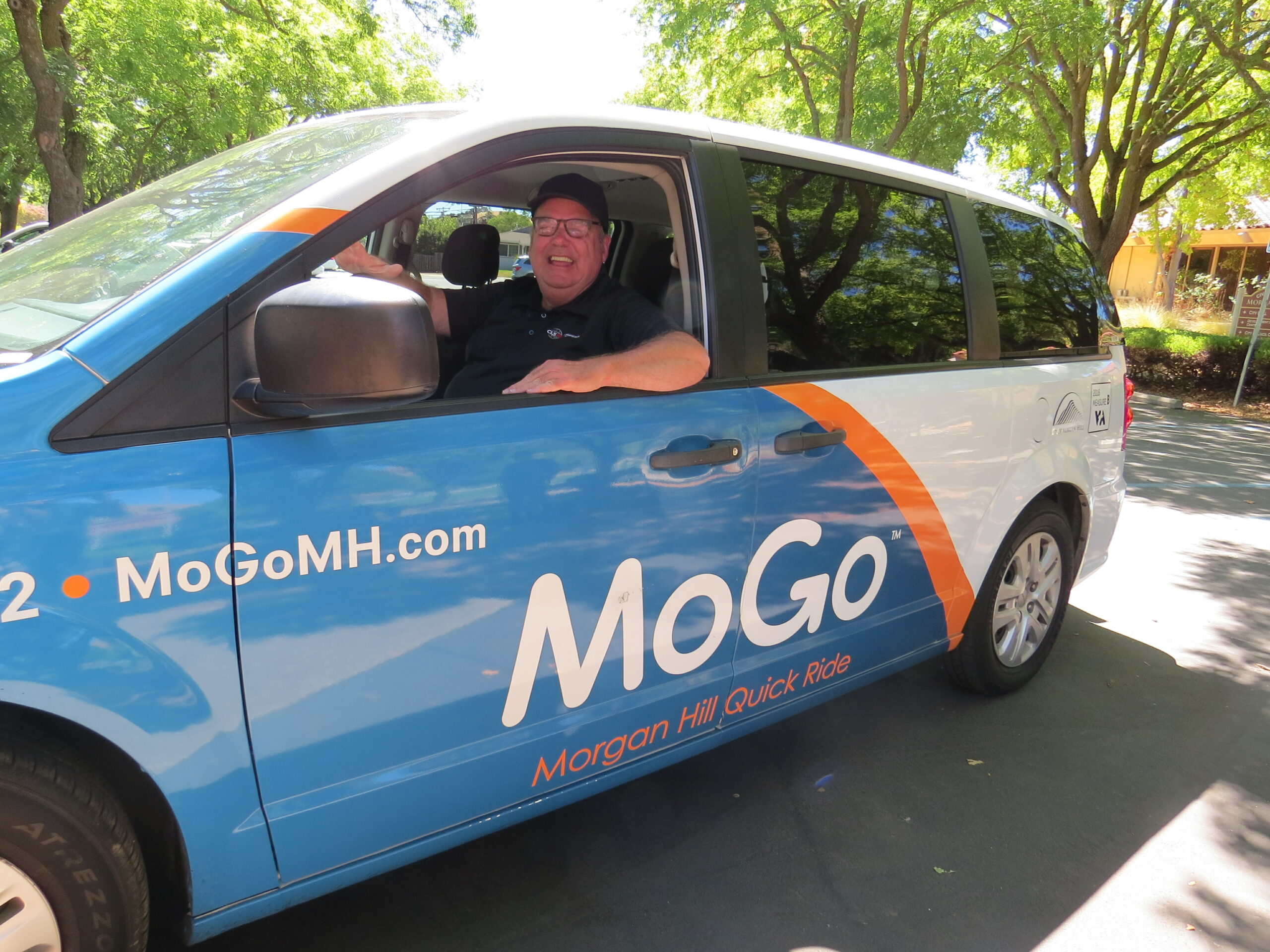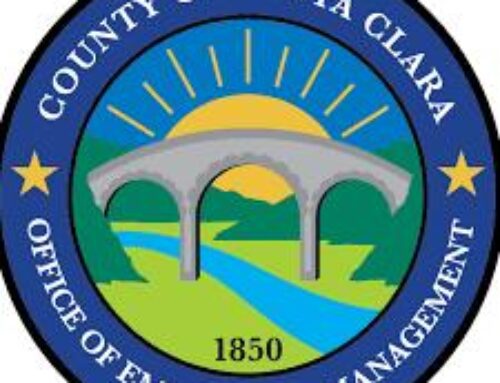Experimental pilot program will be evaluated by city at the end of year
![]()

Photo by Calvin Nuttall
MoGo driver Joseph Colgan drives people throughout Morgan Hill for the low fare of $2.50 for adults. Children and teens ride for $1.
By Calvin Nuttall
 Morgan Hill residents are ditching their car keys and embracing their smartphones in favor of MoGo, the city’s own local last-mile ride sharing system.
Morgan Hill residents are ditching their car keys and embracing their smartphones in favor of MoGo, the city’s own local last-mile ride sharing system.
MoGo Morgan Hill Quick Ride, MoGo for short, is a pilot program made possible through a partnership between the city, the Valley Transportation Authority, and Rideco, Inc. Started in 2022 with the goal of connecting short trips between local destinations for Morgan Hill residents, MoGo provides an affordable linkage between other local modes of public transport such as Caltrain and VTA’s bus services.
“I think it’s a great service for Morgan Hill,” said George Martinez, one of MoGo’s seven drivers. “It’s perfect for a town like this, because the bus doesn’t go everywhere. We’re an extension of VTA, basically. We go everywhere.”
Similar to other ride-sharing services, MoGo functions mainly through the use of an app, though there is also a telephone number that clients can call to request rides. The majority of payments are made electronically through the app, though drivers are also able to accept cash. Rides are $2.50 for adults, $1 for children. One difference between MoGo and other popular rideshares is their use of virtual stops as pick-up and drop-off locations, which simplifies the coordination of rides for multiple groups at once.
 “We go anywhere in Morgan Hill,” Martinez said. “All the way from Paradise Valley to Lake Anderson, essentially, and anywhere in between. Hundreds of locations throughout the city. They did a good job picking locations, because we’re no more than one or two stops or blocks away from anyone where they live.”
“We go anywhere in Morgan Hill,” Martinez said. “All the way from Paradise Valley to Lake Anderson, essentially, and anywhere in between. Hundreds of locations throughout the city. They did a good job picking locations, because we’re no more than one or two stops or blocks away from anyone where they live.”
MoGo had a slow start when it first began, Martinez said, but has grown in popularity since then.
He credits the efforts of city officials including Public Services Director Chris Ghione for their efforts in spreading word of the availability of the new service.
“He was riding with us and taking videos and posting them on Facebook, the city page, and all that stuff, and it picked up tremendously,” he said. “At first it was a little slow, because not many people knew about it. Then we got a big boost.”
The service provides mobility to residents who may otherwise be having difficulties with securing transportation about town.
“It’s been really nice, it really comes in handy,” said Shawn Franco, a frequent MoGo rider. “These guys always come through. It’s reliable and affordable. There have been so many times that I’ve needed it, when my car breaks down or something. It has been a lifesaver, for sure.”
Not only is the service convenient, Franco said, but it offers a personal connection he doesn’t get from other ridesharing services. Because of the small pool of drivers in MoGo’s system, a regular client is almost always going to be picked up by somebody they have met before.
“This guy is the guy, he is like the coolest dude ever,” Franco said of Martinez. “We strike up conversations, and he is easy to talk to. When I get rides with Uber or something like that, it’s awkward. They’re always awkward. This guy picks me up and I feel like he’s a homie. We have conversations and stuff, I like it a lot.”
 The largest group of clients he serves are high school students, Martinez said. During after-school hours, he makes trip after trip to Sobrato or Live Oak high schools to pick up batches of students and drop them off at their preferred virtual stops throughout the city.
The largest group of clients he serves are high school students, Martinez said. During after-school hours, he makes trip after trip to Sobrato or Live Oak high schools to pick up batches of students and drop them off at their preferred virtual stops throughout the city.
“I’ve had multiple occasions where, at the same time, you have, like, at least three or four students and you have multiple drop-offs,” he said. “Same pickup, as far as the high school, multiple drop-offs. This past May, during the celebrations for graduations and stuff, I’ve had families coming with me for their kids.”
During the weekends and summer, the service also helps many minors who aren’t yet able to drive themselves to get to their part-time jobs around town, including Robin Janssen, 15, who works as a lifeguard at the Centennial Recreation Center.
“I’ve used the service probably like five times now, in the past six months,” he said. “I can’t drive yet, and when my parents are at work and I need a ride, they’re not home, so this is an easy and cheap way. It’s way cheaper than Uber. It’s only Morgan Hill, but that’s fine with me, cause I live here.”
For Kenneth Tucker, MoGo offers a way to cut down on the hassle of using his own car for simple trips around town, such as to the gym.
“I’d say I use the service pretty often, two to three times a week,” he said. “I think it’s great. Sometimes I don’t always feel like driving places, so it’s an efficient way to get around, especially locally. If I’m going to San Jose or something, obviously I can drive, but around town it’s great to just use MoGo.”
 MoGo also provides an essential service to senior residents who are no longer able to drive, but they still need to get to work or run errands on their own.
MoGo also provides an essential service to senior residents who are no longer able to drive, but they still need to get to work or run errands on their own.
“For seniors, a lot of the time, the app is difficult to use,” Martinez said. “Luckily, there is also a phone number they can call.”
With only three vans and seven drivers, the lightweight pilot program helps to fill the gaps in the VTA’s more large-scale public transit options.
“It actually saves money for the VTA this way,” Martinez said. “By doing this program, instead of running huge buses, we aren’t using as much fuel. We only have three vans running at any time and it pretty much is enough, most of the time, except for the peaks, like school time.”
The Innovative Transit program, which funds MoGo, is due to sunset at the end of this year, unless the city and VTA secure additional funding to sustain it.
The program’s ridership has improved substantially in recent months, Martinez said, and he hopes the increase in popularity will encourage city officials to find a way to keep the program going.
“I think it’s going to come down to ridership,” he said. “It’s not about the fares, since it’s (mostly) funded by the VTA. As long as people use the service, that’s all that matters.”
Calvin Nuttall is a Morgan Hill-based freelance reporter and columnist.






